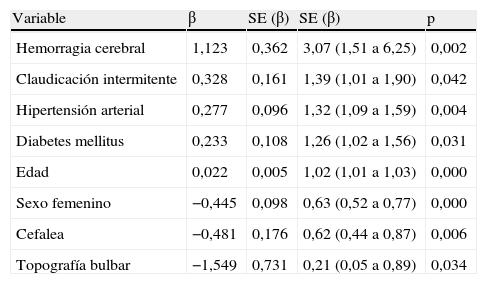Analizar las características demográficas, pronósticas y el perfil clínico relacionados con los infartos cerebrales recurrentes (ICR).
Pacientes y métodoEstudio hospitalario descriptivo de 605 pacientes consecutivos ingresados durante un período de 17 años por presentar ICR. Se efectúa una comparación con 2.099 pacientes con un primer infarto cerebral.
ResultadosLos ICR representan el 22,4% del total de infartos cerebrales. Se observaron ICR en el 26,2% de los infartos trombóticos, en el 24,4% de los cardioembólicos, en el 21,8% de los lacunares, en el 15,8% de los infartos inhabituales y en el 12% de los infartos esenciales. Los ICR tienen un peor pronóstico que los infartos no recurrentes, presentando una mayor mortalidad hospitalaria (16,2 frente al 12%; p=0,005) y una menor frecuencia de ausencia de limitación al alta hospitalaria (17,8 frente al 27,3%; p=0,0001). El perfil clínico significativamente asociado con los ICR fue: presencia de hemorragia cerebral previa (odds ratio [OR] 3,07; intervalo de confianza del 95% [IC 95%] 1,51-6,25), claudicación intermitente (OR 1,39; IC 95% 1,01-1,90), hipertensión arterial (OR 1,32; IC 95% 1,09-1,59), diabetes mellitus (OR 1,26; IC 95% 1,02-1,56), edad (OR 1,02; IC 95% 1,01-1,03), sexo femenino (OR 0,63; IC 95% 0,52-0,77), cefalea (OR 0,62; IC 95% 0,44-0,87) y la topografía bulbar (OR 0,21; IC 95% 0,05-0,89).
ConclusionesLos ICR constituyen aproximadamente una cuarta parte de los infartos cerebrales, siendo más frecuentes en los infartos trombóticos y en los cardioembólicos. Tienen un peor pronóstico, con una mayor mortalidad hospitalaria y una menor frecuencia de ausencia de limitación al alta. Presentan un perfil clínico diferenciado de los primeros infartos cerebrales.
To characterize the clinical factors and prognosis and identify determinants of ischemic stroke recurrence in acute stroke.
Patients and methodsRecurrent stroke patterns were studied in 605 consecutive patients admitted with a second or further ischemic stroke to the Department of Neurology of the Sagrat Cor Hospital of Barcelona over a 17 year period. Demographic, risk factors, clinical, neuroimaging and outcome variables were analyzed and compared with patients with first-ever cerebral infarction (n=2.099) to identify predictors of ischemic recurrent stroke. Significant variables were entered into a multivariate logistic regression analysis.
ResultsIschemic recurrent strokes accounted for 22.4% of all acute consecutive ischemic strokes. Frequency of ischemic stroke recurrence were significantly different among ischemic stroke subtypes: 26.2% in atherothrombotic, 24.4% in cardioembolic, 21.8% in lacunar stroke, 15.8% in infarcts of unusual etiology and 12% infarctions of uncertain etiology. The overall in-hospital mortality and symptom free at discharge in recurrent vs. non-recurrent stroke patients rate was 16.2 vs. 12% (p=0.005) and 17.8 vs. 27.3% (p=0.0001) respectively. Previous intracerebral hemorrhage (OR=3.07; 95% CI, 1.51-6.25), intermittent claudication (OR=1.39; 95% CI, 1.01-1.90), arterial hypertension (OR=1.32; 95% CI, 1.09-1.59), diabetes mellitus (OR=1.26; 95% CI, 1.02-1.56), age (OR=1.02; 95% CI, 1.01-1.03), female gender (OR=0.63; 95% CI, 0.52-0.77), headache (OR=0.62; 95% CI, 0.44-0.87) and bulbar topography (OR=0.21; 95% CI, 0.05-0.89) were independent clinical variables related to ischemic stroke recurrence.
ConclusionsAbout one in every four patients with ischemic stroke had an ischemic stroke recurrence. In-hospital mortality is 16.2% and clinical profiles were different in ischemic stroke recurrence when compared to first-ever ischemic stroke patients.
Artículo
Comprando el artículo el PDF del mismo podrá ser descargado
Precio 19,34 €
Comprar ahora








